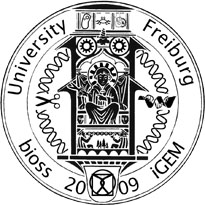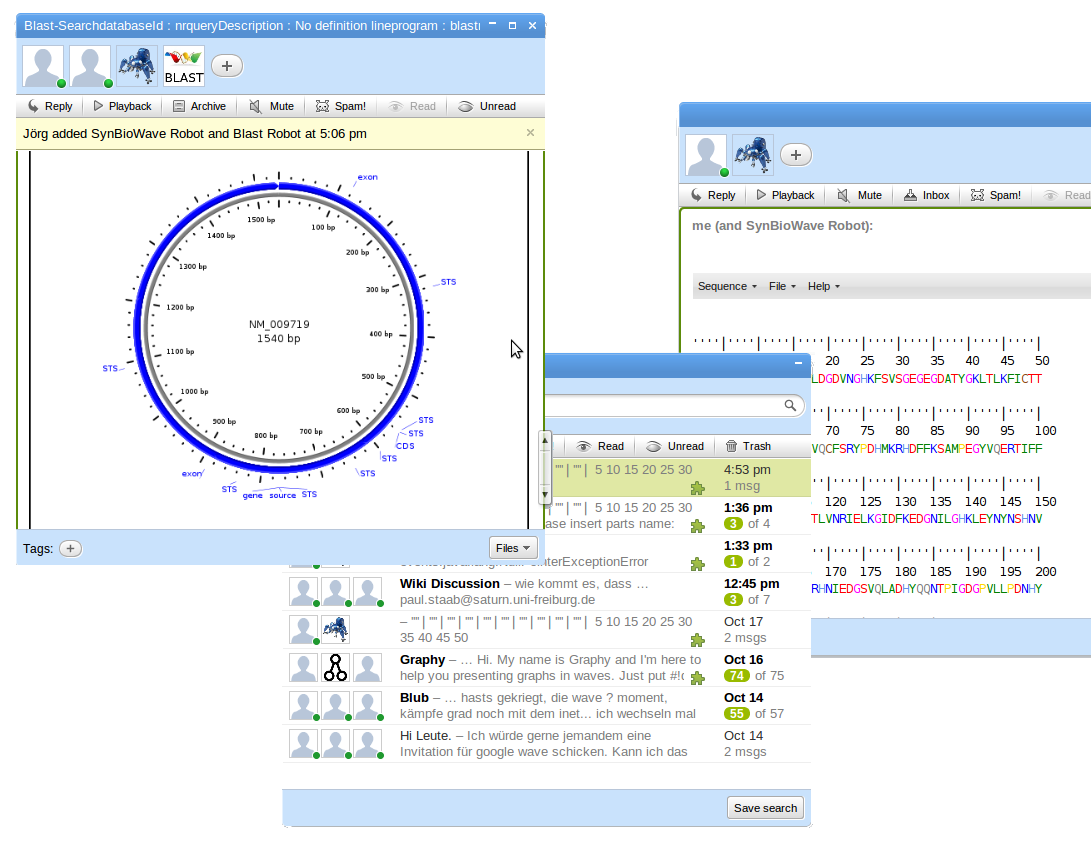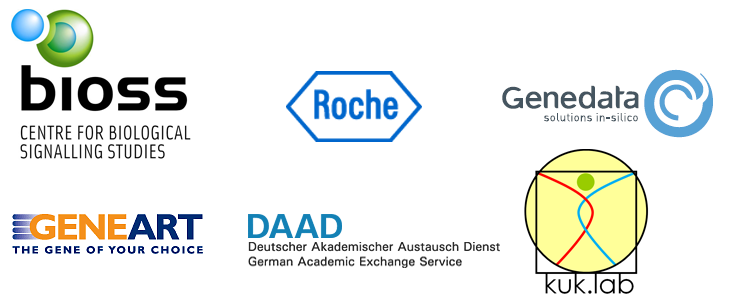Team:Freiburg software
From 2009.igem.org
(→SynBioWave) |
|||
| (66 intermediate revisions not shown) | |||
| Line 1: | Line 1: | ||
| - | < | + | <div style="display: none;"><html><style> |
| - | + | #tabs a.home_active { | |
| - | < | + | background-position:0% -42px; |
| - | <style | + | } |
| - | + | #tabs a.home_active span { | |
| - | + | background-position:100% -42px; | |
| + | color:#213340; | ||
| + | } | ||
| + | #toc { | ||
| + | display:none; | ||
| + | } | ||
| + | </style></html></div> | ||
| + | {{:Team:Freiburg_software/Templates/Header}} | ||
| - | + | =Project Summary= | |
| - | + | ||
| - | + | [[Image:Freiburg09_Kuklab_logo.jpg|left|border]] | |
| - | + | ||
| - | + | ==Team Freiburg Software== | |
| - | + | ||
| - | + | As the first German software team we are proud to present our ambitious project, a synthetic biological software suite, based on Google's collaboration and communication tool Wave. Announced as the reinvention of the email, chat and wiki, Wave represents an extensible, modular and real-time collaboration platform. On this basis, we built a suite for collaborative synthetic biology research comprising parts design and documentation. To reflect the symbioses of Wave with synthetic biological tools, our software is called '''SynBioWave'''. | |
| - | + | ||
| - | + | <br style="clear: both" /> | |
| - | + | ||
| - | + | ==Abstract== | |
| - | + | Synthetic Biology, which aims at constructing whole new genomes, is pushed forward by many users and relies on the assembly of genetic elements to devices and later systems. The construction process needs to be transparent and even at final stages control at the basepair level is required. We are building a software environment enabling multiple distributed users to analyze and construct genetic parts and ultimately genomes with real-time communication. Our current version demonstrates the principle use as well as the power of the underlying Google Wave protocol for collaborative synthetic biology efforts. Many wave-robots with a manageable set of capabilities will divide and conquer the complex task of creating a genome in silico. The initial developments of 'SynBioWave' lay the ground for basic layout, calling and data exchange of wave-robots in a clear and open process, so that future robots can be added and shared easily. | |
| - | + | ||
| - | + | ==SynBioWave== | |
| - | + | ||
| - | + | [[Image:Freiburg_software_SynBioWave-look-and-feel.png|550px|right]] | |
| - | + | ||
| - | + | We have created an open-source, '''synthetic biological software suite''' called SynBioWave. Based on Google's communication tool Wave, SynBioWave is made for '''collaborative research''' comprising parts design and documentation. Moreover, biologists can record and share the process of creating research data and perform basic tasks using SynBioWave. This gives synthetic biology access to the collaborative and interactive web 2.0. | |
| - | + | ||
| - | + | We created this web based software as a biological collaboration platform on top of Google Wave. This included the work on displaying biological sequence data, importing and exporting such data from different sources, supporting a large range of sequence formats, such as FASTA, GenBank and EMBL. To realize the implementation, we even invented a communication protocol called qooxWave. We solved the problem of multi-robot communication and extended Wave's user interface for our purpose. | |
| - | + | ||
| - | + | The result of four month development is enjoyable! We have extended Wave to handle synthetic biological data. Biologists can not only document research results, but also record and share the process of creating these. Moreover scientists can collaboratively perform basic biosynthetic tasks using SynBioWave. | |
| - | <div class=" | + | |
| - | + | Our small team of three developers is not able to create a feature complete software for iGEM Jamboree 2009. Our goal is to lay the foundation for a robust software suite and to implement some basic synthetic biological functionality to demonstrate the principle use, with some molecular biology standard tasks. Moreover, we want to demonstrate the power of the wave approach for a distributed collaborative synthetic biology effort. | |
| - | + | ||
| + | ==Quickstart== | ||
| + | <div class="tableofcontents"> | ||
| + | # '''[[Team:Freiburg_software/Project|The Project]]''' A detailed project description including SynBioWave and the presentation of our work | ||
| + | # '''[[Team:Freiburg_software/Code|The Code]]''' A repository of important classes plus an archive with all code we wrote | ||
| + | # '''[[Team:Freiburg_software/UserGuide|User Guide]]'''You want to try out SynBioWave? Have a look here! | ||
</div> | </div> | ||
| - | + | ||
| - | + | =Sponsors= | |
| - | + | [[Image:Freiburg09_Sponsors.png|center]] | |
| - | + | ||
| - | + | ||
| - | + | ||
| - | + | ||
| - | + | ||
| - | + | ||
| - | + | ||
| - | + | ||
| - | + | ||
| - | + | ||
| - | + | ||
| - | + | ||
| - | + | ||
| - | + | ||
| - | + | ||
| - | + | ||
| - | + | ||
| - | + | ||
| - | + | ||
| - | + | ||
| - | + | ||
| - | + | ||
| - | + | ||
| - | + | ||
| - | + | ||
| - | + | ||
| - | + | ||
| - | + | ||
| - | + | ||
| - | + | ||
| - | + | ||
| - | + | ||
| - | + | ||
| - | + | ||
| - | + | ||
| - | + | ||
| - | + | ||
| - | + | ||
| - | + | ||
| - | + | ||
| - | + | ||
| - | + | ||
| - | + | ||
| - | + | ||
| - | + | ||
| - | + | ||
| - | + | ||
| - | + | ||
| - | + | ||
| - | + | ||
| - | + | ||
| - | + | ||
| - | + | ||
| - | + | ||
| - | + | ||
| - | + | ||
| - | + | ||
| - | + | ||
| - | + | ||
| - | + | ||
| - | + | ||
| - | + | ||
| - | + | ||
| - | + | ||
| - | + | ||
| - | + | ||
| - | + | ||
| - | + | ||
| - | + | ||
| - | + | ||
| - | + | ||
| - | + | ||
| - | + | ||
| - | + | ||
| - | + | ||
| - | + | ||
| - | + | ||
| - | + | ||
| - | + | ||
| - | + | ||
| - | + | ||
| - | + | ||
| - | + | ||
| - | + | ||
| - | + | ||
| - | + | ||
| - | + | ||
| - | + | ||
| - | + | ||
| - | + | ||
| - | + | ||
| - | + | ||
| - | + | ||
| - | + | ||
| - | + | ||
| - | + | ||
| - | + | ||
| - | + | ||
| - | + | ||
| - | + | ||
| - | + | ||
| - | + | ||
| - | + | ||
| - | + | ||
| - | + | ||
| - | + | ||
| - | + | ||
| - | + | ||
| - | + | ||
| - | + | ||
| - | + | ||
| - | + | ||
| - | + | ||
| - | + | ||
| - | + | ||
| - | + | ||
| - | + | ||
| - | + | ||
| - | + | ||
| - | + | ||
| - | + | ||
| - | + | ||
| - | + | ||
| - | + | ||
| - | + | ||
| - | + | ||
| - | + | ||
| - | + | ||
| - | + | ||
| - | + | ||
| - | + | ||
| - | + | ||
| - | + | ||
| - | + | ||
| - | + | ||
| - | + | ||
| - | + | ||
| - | + | ||
| - | + | ||
| - | + | ||
| - | + | ||
| - | + | ||
| - | + | ||
| - | + | ||
| - | + | ||
| - | + | ||
| - | + | ||
| - | + | ||
| - | + | ||
| - | + | ||
| - | + | ||
| - | + | ||
| - | + | ||
| - | + | ||
| - | + | ||
| - | + | ||
| - | + | ||
| - | + | ||
| - | + | ||
| - | + | ||
| - | + | ||
| - | + | ||
| - | + | ||
| - | + | ||
| - | + | ||
| - | + | ||
| - | + | ||
| - | + | ||
| - | + | ||
| - | + | ||
| - | + | ||
| - | + | ||
| - | + | ||
| - | + | ||
| - | + | ||
| - | + | ||
| - | + | ||
| - | + | ||
| - | + | ||
| - | + | ||
| - | + | ||
| - | + | ||
| - | + | ||
| - | + | ||
| - | + | ||
| - | + | ||
| - | + | ||
| - | + | ||
| - | + | ||
| - | + | ||
| - | + | ||
| - | + | ||
| - | + | ||
| - | + | ||
| - | + | ||
| - | + | ||
| - | + | ||
| - | + | ||
| - | + | ||
| - | + | ||
| - | + | ||
| - | + | ||
| - | + | ||
| - | + | ||
| - | + | ||
| - | + | ||
| - | + | ||
| - | + | ||
| - | + | ||
| - | + | ||
| - | + | ||
| - | + | ||
| - | + | ||
| - | + | ||
| - | + | ||
| - | + | ||
| - | + | ||
| - | + | ||
| - | + | ||
| - | + | ||
| - | + | ||
| - | + | ||
| - | + | ||
| - | + | ||
| - | + | ||
Latest revision as of 00:43, 22 October 2009
Contents |
Project Summary
Team Freiburg Software
As the first German software team we are proud to present our ambitious project, a synthetic biological software suite, based on Google's collaboration and communication tool Wave. Announced as the reinvention of the email, chat and wiki, Wave represents an extensible, modular and real-time collaboration platform. On this basis, we built a suite for collaborative synthetic biology research comprising parts design and documentation. To reflect the symbioses of Wave with synthetic biological tools, our software is called SynBioWave.
Abstract
Synthetic Biology, which aims at constructing whole new genomes, is pushed forward by many users and relies on the assembly of genetic elements to devices and later systems. The construction process needs to be transparent and even at final stages control at the basepair level is required. We are building a software environment enabling multiple distributed users to analyze and construct genetic parts and ultimately genomes with real-time communication. Our current version demonstrates the principle use as well as the power of the underlying Google Wave protocol for collaborative synthetic biology efforts. Many wave-robots with a manageable set of capabilities will divide and conquer the complex task of creating a genome in silico. The initial developments of 'SynBioWave' lay the ground for basic layout, calling and data exchange of wave-robots in a clear and open process, so that future robots can be added and shared easily.
SynBioWave
We have created an open-source, synthetic biological software suite called SynBioWave. Based on Google's communication tool Wave, SynBioWave is made for collaborative research comprising parts design and documentation. Moreover, biologists can record and share the process of creating research data and perform basic tasks using SynBioWave. This gives synthetic biology access to the collaborative and interactive web 2.0.
We created this web based software as a biological collaboration platform on top of Google Wave. This included the work on displaying biological sequence data, importing and exporting such data from different sources, supporting a large range of sequence formats, such as FASTA, GenBank and EMBL. To realize the implementation, we even invented a communication protocol called qooxWave. We solved the problem of multi-robot communication and extended Wave's user interface for our purpose.
The result of four month development is enjoyable! We have extended Wave to handle synthetic biological data. Biologists can not only document research results, but also record and share the process of creating these. Moreover scientists can collaboratively perform basic biosynthetic tasks using SynBioWave.
Our small team of three developers is not able to create a feature complete software for iGEM Jamboree 2009. Our goal is to lay the foundation for a robust software suite and to implement some basic synthetic biological functionality to demonstrate the principle use, with some molecular biology standard tasks. Moreover, we want to demonstrate the power of the wave approach for a distributed collaborative synthetic biology effort.
Quickstart
- The Project A detailed project description including SynBioWave and the presentation of our work
- The Code A repository of important classes plus an archive with all code we wrote
- User GuideYou want to try out SynBioWave? Have a look here!
 "
"


